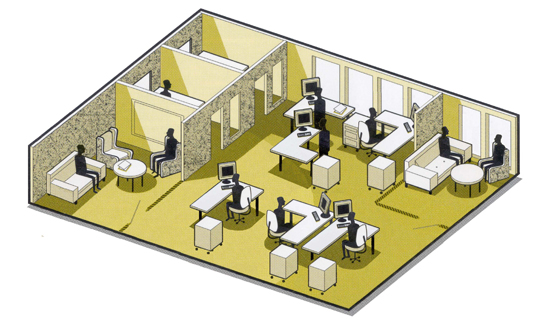


Noise and Perceived Privacy – Flexible Office Space Matters
C. Bodin Danielsson, christina.bodin.danielsson@bredband.net
School of Architecture & Built Environment
The Royal Institute of Technology, KTH
Östermalmsgatan 26,
100 44 Stockholm, Sweden
Popular version of paper 1pAAa3
"Differences in perception of noise and privacy in different office types"
In the office, the physical environment has a profound influence on employees’ general job satisfaction. The perception of privacy and noise is of specific interest in this regard due to its impact on job satisfaction and general satisfaction among employees.
In a study, 469 employees in 26 different companies in Stockholm, Sweden rated their satisfaction with the office environment in seven different office types , defined by their architectural and functional features. The office types are: 1) cell-office, one person per room; 2) shared roomoffice, two to three people per room; Traditonal open plan offices, devided into three office types: 3) small open plan office, with four to nine people per room; 4) medium-sized open plan office, with10-24 people per room; 5) large open plan office, more than 24 people per room; and more flexible office types: 6) flex-office, the most flexible office type, with no personal workstations and good access to back-up spaces; and 7) combi-office, defined by teamwork, sharing of common facilities, and good access to back-up spaces.
The responses to the survey were statistically weighed to eliminate the influence of factors such as age, gender, job rank, and line of business, and the results of the study show substantial differences between employees’ perception of noise and privacy in different office types.
The overall analysis shows that the people most satisfied with the noise and privacy situation of all office employees were those working in cell-offices. This came as no surprise. What was surprising, however, was the fact that there were such differences between different types of offices involving the shared of workspace.. Among people working in shared office environments, the m ost satisfied were those in flex-offices. The least satisfied were those in large open plan offices Concern for being observed (visual privacy) was equal among those in cell-offices and those in flex-offices. Those in cell-offices were also least concerned about being overheard (acoustic privacy), and they were , followed closely by those in flex-offices. The greatest levels of dissatisfaction for privacy were reported by those in traditional open plan offices.
The discrepancy between acoustic and visual privacy is interesting with regard to its relation to the experience of possibility for seclusion within workspace. Despite the fact that a great majority of those in flex-offices reported no possibility for seclusion, employees in this office type also reported lower perceived problems with being overheard or being observed.

Cell-office

Traditional open plan office

Flex-office
Source: Bodin Danielsson, C., & Bodin, L. (In press). Office Environment and Employees´ Satisfaction: The Impact of Office-type. Journal of Architectural and Planning Research.
Thus environmental stress like noise and lack of privacy will occur more often in offices where workspace and facilities are shared. It is known that environmental factors that give rise to stress reactions like noise and interference in privacy are handled by different copying strategies at an individual level. The results of this study indicate that open plan office, in addition to cell offices, can also meet privacy needs. The good result in terms of noise and privacy among flex-office employees show that flex-office offers the employees personal control by letting them choose workstation at the office depending on different needs or at home when needed.
In the traditional open plan offices (small, medium-sized and large open plan office) the employee has a personal workstation in a shared workspace but no ability to seek privacy when needed since there is a lack of back-up rooms or more flexible work ways.
To conclude, the results show that it is not useful to discuss open plan office the way it is done today since there are different architectural and functional features that differentiate these office types, which in turn leads to different working conditions. It is highly important to recognize the relation between perception of privacy and noise, since it is known that privacy has a mediating effect on negative stimuli such as noise. With knowledge of the architectural and functional features importance for these issues costly mistakes for organizations such as a decreased environmental satisfaction and job satisfaction among employees can be avoided for organizations in the design process of offices.